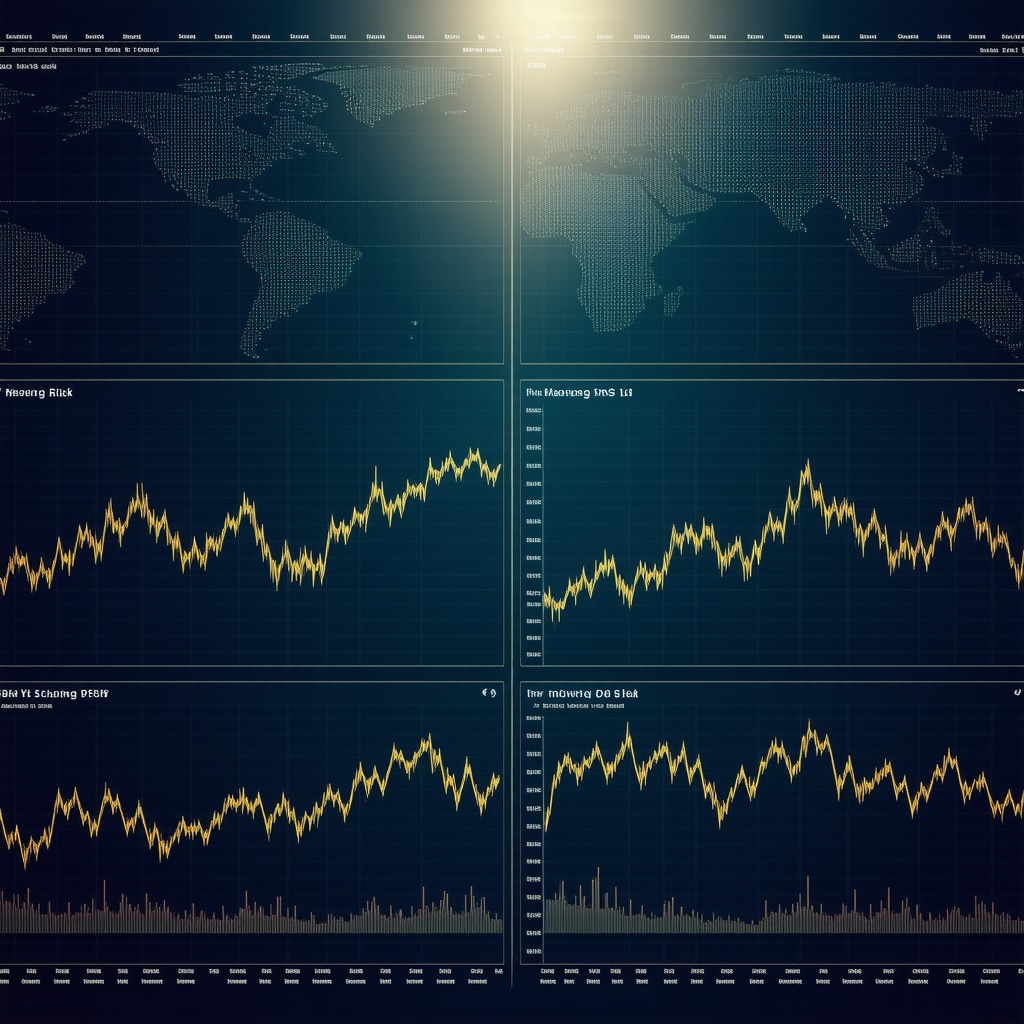Unlocking Gold’s Multifaceted Potential: Why Diversify Your Gold Investments?
Gold has long stood as a beacon of financial security and wealth preservation, but navigating its investment landscape requires more than simply buying physical bars. For beginners, creating a diversified gold investment portfolio is a strategic art that balances risk, liquidity, and growth potential. Instead of placing all capital into one form, diversification harnesses different gold-related assets to capitalize on market dynamics and safeguard wealth against volatility and inflation.
Exploring the Spectrum: Varied Gold Investment Vehicles to Consider
Diversification in gold investing extends beyond bullion. Physical gold, such as coins and bars, offers tangible ownership and intrinsic value, yet it necessitates secure storage and insurance. Meanwhile, gold ETFs and mutual funds provide liquidity and ease of trading, ideal for investors seeking market exposure without handling the metal directly. For those willing to venture deeper, gold mining stocks and futures contracts introduce elements of leverage and corporate growth potential but come with amplified risks.
Consider the example of an investor allocating 40% in physical gold bars, 30% in gold ETFs, 20% in mining stocks, and 10% in gold futures. This blend allows for portfolio stability through physical assets while leveraging market opportunities in equities and derivatives.
Hedging Against Uncertainty: How Gold Acts as a Shield in Your Portfolio
Gold’s reputation as a hedge against inflation and market turbulence is well-founded. Its inverse correlation with paper assets like stocks and bonds makes it a strategic buffer during economic downturns. By diversifying across gold assets, investors can optimize this protective quality. For instance, physical gold maintains value during crises, while gold ETFs offer rapid liquidity to capitalize on market swings.
How Can Beginners Balance Risk and Reward When Building a Gold Portfolio?
Balancing risk and reward involves understanding each gold investment type’s characteristics. Physical gold is low risk but less liquid; mining stocks offer growth but are susceptible to market and operational risks; ETFs balance liquidity and exposure; futures require sophisticated knowledge and risk tolerance. Beginners should start with simpler instruments like physical gold and ETFs before gradually exploring stocks and futures. Regularly reviewing market trends and demand drivers—such as central bank purchases and global economic indicators—can refine allocation strategies over time.
Strategic Storage and Security: Protecting Your Physical Gold Assets
Owning physical gold demands thoughtful security measures. Safe storage options range from home safes to professional vault services, each with trade-offs in convenience, cost, and insurance coverage. Experts recommend professional storage for larger holdings to mitigate theft or loss risks. This approach reinforces the portfolio’s integrity, ensuring that physical assets retain their value and accessibility when needed.
Deepen Your Gold Investment Knowledge
For those ready to embark on this journey, resources like best practices for safe storage of physical gold and choosing the right gold investment vehicles offer invaluable insights. These guides complement foundational knowledge with practical tips to build a resilient and diversified gold portfolio.
Gold’s multifaceted investment opportunities reward the informed and patient investor. Engage with the community by sharing your experiences or questions about gold diversification strategies in the comments below to foster collective wisdom and confidence.
Authoritative insight referenced from the World Gold Council’s comprehensive reports on gold investment trends and portfolio strategies, a recognized global authority in precious metals research.
The Personal Journey: Learning to Navigate Gold Investment Risks and Rewards
When I first ventured into gold investments, I was eager but admittedly naive about the nuances involved. My initial approach was straightforward: buy physical gold bars and keep them stored at home. While this gave me a tangible sense of security, I quickly realized that relying solely on physical gold limited my portfolio’s growth potential and liquidity. This personal experience underscored the importance of diversification — a lesson many beginners discover the hard way.
Transitioning to include gold ETFs was a game-changer for me. ETFs allowed me to maintain exposure to gold’s price movements without the hassle of physical storage. Plus, I could buy or sell shares easily, which gave me much-needed flexibility during volatile market periods. However, I still kept a portion of physical gold for its psychological comfort and as a hedge against extreme economic instability.
Recognizing Market Signals: The Role of Central Banks and Global Trends
One insight that deepened my appreciation for gold investing was understanding how central bank purchases influence gold prices. According to the World Gold Council, central banks have been steadily increasing their gold reserves, signaling confidence in gold as a strategic asset amid global economic uncertainties. Watching these trends helped me time my investments better and diversify into gold mining stocks, which tend to benefit when central banks ramp up buying.
Additionally, global demand trends such as rising jewelry consumption in emerging markets and technological uses in electronics also affect gold prices. By keeping an eye on these demand drivers, I was able to fine-tune my gold portfolio allocation periodically to balance stability and growth.
What Are Your Experiences or Questions About Balancing Gold Investments?
Given my journey, I’m curious about your thoughts and experiences with gold diversification. Have you found a particular mix of physical gold, ETFs, mining stocks, or futures that works best for your financial goals? Are there challenges you’ve faced in managing storage or risk? Feel free to share in the comments below — your stories and questions can enrich our collective understanding and help others navigate this fascinating investment landscape.
Practical Tips for Safeguarding Physical Gold and Avoiding Common Pitfalls
From my experience, once you commit to physical gold, securing it is non-negotiable. I opted for a professional vault storage service that offers insurance and high-level security, which relieved me from the anxiety of potential theft or damage at home. While this comes with a fee, the peace of mind and preservation of asset value far outweigh the cost. For those interested, detailed advice on best practices for safe storage of physical gold can help you make an informed decision.
Also, a common mistake I’ve seen among beginners is chasing price spikes or buying gold from unreliable dealers. Always do thorough research or consult trusted sources before purchasing. Selecting reputable dealers ensures authenticity and fair pricing, which is crucial for protecting your investment.
Continuing the Learning Curve: Where to Dive Deeper
If you’re eager to broaden your knowledge further, exploring resources on choosing the right gold investment vehicles can provide clarity on what fits your risk profile and investment horizon. For a step-by-step approach, beginner guides on investing in gold for beginners offer structured paths to build your portfolio confidently.
Remember, gold investing is a journey of continuous learning and adaptation. By staying informed and sharing insights, we can collectively build smarter, more resilient portfolios that stand the test of economic cycles.
Harnessing Macro-Economic Indicators: Advanced Gold Investment Signals Beyond the Basics
Taking your gold investment strategy to an expert level requires a nuanced understanding of macroeconomic indicators that influence gold’s price trajectory. Beyond the well-known inflation hedge narrative, factors such as real interest rates, currency strength, and geopolitical tensions serve as leading signals that sophisticated investors monitor closely. For example, gold typically benefits when real yields on government bonds fall into negative territory, as the opportunity cost of holding non-yielding gold diminishes. Similarly, fluctuations in the U.S. dollar index significantly affect gold pricing because gold is dollar-denominated globally.
Seasoned investors also track central bank policies, including quantitative easing programs and foreign exchange reserves diversification, which can create sustained demand for gold. Additionally, mining production trends—such as declining ore grades—impact supply-side dynamics, often supporting price appreciation. Integrating these data points into a dynamic allocation model can enhance timing and positioning, allowing investors to capitalize on market inefficiencies.
How Do Geopolitical Risks and Currency Volatility Specifically Impact Gold Investment Strategies?
Geopolitical risks, including conflicts, trade wars, and diplomatic tensions, often trigger flight-to-safety demand for gold, as it is perceived as a reliable store of value amid uncertainty. For instance, during periods of heightened Middle Eastern tensions or escalating tariffs, gold prices have historically surged as investors seek protection against market instability.
Currency volatility, particularly the strength or weakness of the U.S. dollar, inversely influences gold prices. A weakening dollar makes gold cheaper in other currencies, boosting international demand. Conversely, a strong dollar can suppress gold prices by making it more expensive globally. Expert investors often employ currency hedging strategies or diversify across currency zones to mitigate these risks while maintaining gold exposure.
Quantitative Approaches: Utilizing Technical and Sentiment Analysis for Gold Trading
Beyond fundamental analysis, advanced investors apply quantitative techniques to refine entry and exit points in gold markets. Technical indicators such as moving averages, relative strength index (RSI), and Fibonacci retracements provide insights into price momentum and potential reversals. Incorporating volume analysis and open interest data from futures markets adds further depth, highlighting shifts in market participation and sentiment.
Sentiment analysis tools, leveraging social media trends, news sentiment, and positioning reports like the Commitment of Traders (COT), enable investors to gauge market psychology. For example, extreme bullishness among retail traders may signal a contrarian sell opportunity, while bearish sentiment could indicate undervaluation. Combining these approaches with robust risk management frameworks helps in constructing adaptive gold trading strategies aligned with evolving market conditions.
Integrating Gold Within a Broader Multi-Asset Portfolio: Correlation and Diversification Insights
While gold is traditionally viewed as a portfolio diversifier, its correlation with other asset classes varies over time. Advanced portfolio construction leverages dynamic correlation matrices to optimize gold allocation relative to equities, bonds, real estate, and alternative investments. During systemic crises, gold’s negative or low correlation with risk assets typically increases its value as a safe haven.
Modern portfolio theory and advanced optimization algorithms, such as mean-variance optimization and Black-Litterman models, can quantify the incremental benefit of gold inclusion. Tactical asset allocation further refines exposure based on macroeconomic outlooks and risk-on/risk-off market phases. Investors who dynamically adjust allocations in response to shifting correlations and volatility regimes stand to enhance portfolio resilience and returns.
What Are the Best Practices for Managing Liquidity and Counterparty Risks in Gold Derivatives?
Gold derivatives, including futures and options, offer leverage and flexibility but introduce counterparty and liquidity risks. Best practices involve trading on regulated exchanges with transparent clearinghouses to mitigate counterparty default risk. Maintaining adequate margin and employing stop-loss orders are essential risk control measures. Additionally, investors should be cognizant of contract specifications, settlement procedures, and rollover costs, which can impact performance.
Choosing derivatives with sufficient market depth and open interest ensures liquidity, enabling timely entry and exit without excessive slippage. Combining derivatives with physical holdings or ETFs can balance liquidity needs with asset security. Diligent monitoring of market conditions and regulatory changes further safeguards derivative positions.
For an authoritative deep dive into these complex topics, the World Gold Council’s Research Hub offers comprehensive data and expert analyses on gold investment trends, market drivers, and best practices.
Ready to elevate your gold investment approach? Dive deeper into these advanced strategies and explore how integrating macroeconomic intelligence, quantitative tools, and risk management can empower your portfolio to thrive amid uncertainty.
Decoding Macro Signals: Elevate Your Gold Investment Acumen
In the realm of gold investment, mastery extends beyond conventional wisdom to a sophisticated interpretation of macroeconomic indicators. Discerning investors monitor real interest rates, currency fluctuations, and geopolitical tensions as pivotal drivers of gold’s price dynamics. For instance, when real yields on treasury bonds dip below zero, gold gains allure by virtue of its zero-yield characteristic, diminishing opportunity costs. Simultaneously, a depreciating U.S. dollar often acts as a catalyst for gold price appreciation given the metal’s dollar-denominated status globally.
Moreover, central bank policies—including quantitative easing and diversification of reserves—signal sustained demand, while supply-side factors like declining ore grades in mining operations further underpin gold’s value proposition. Integrating these multifaceted variables into adaptive portfolio strategies can uncover market inefficiencies and enhance timing precision.
How Do Geopolitical Risks and Currency Volatility Specifically Impact Gold Investment Strategies?
Geopolitical upheavals such as trade disputes, armed conflicts, and diplomatic strains inherently elevate uncertainty, prompting investors to seek refuge in gold as a time-tested safe haven. Historical episodes illustrate price surges during Middle Eastern conflicts or tariff escalations. Concurrently, currency volatility—particularly involving the U.S. dollar—exerts inverse pressure on gold valuations. A weaker dollar reduces gold’s price in other currencies, amplifying global demand, whereas a stronger dollar may dampen it. Advanced investors often employ currency hedging and diversify currency exposure to mitigate these nuanced risks while preserving gold’s portfolio benefits.
Quantitative Techniques: Harnessing Technical and Sentiment Analytics for Strategic Gold Trading
Beyond fundamental insights, quantitative methodologies refine gold market engagement. Technical analysis tools—such as moving averages, relative strength index (RSI), and Fibonacci retracement levels—offer granular visibility into momentum shifts and potential trend reversals. Incorporating volume metrics and open interest data from futures markets further elucidates shifts in institutional and speculative positioning.
Sentiment analytics, leveraging social media trends, news sentiment scoring, and reports like the Commitment of Traders (COT), provide an empirical gauge of market psychology. Elevated retail bullishness can presage corrective downturns, while bearish extremes may reveal buying opportunities. When coupled with disciplined risk management protocols, these tools empower investors to architect resilient, dynamic gold trading frameworks responsive to evolving market conditions.
Integrating Gold Within Multi-Asset Portfolios: Dynamic Correlations and Optimization Strategies
Gold’s role as a diversification cornerstone is nuanced by temporal shifts in its correlation with equities, bonds, and alternative assets. Employing dynamic correlation models allows investors to calibrate gold allocations precisely, enhancing portfolio robustness against systemic shocks. The application of advanced optimization algorithms—such as mean-variance frameworks and Black-Litterman models—quantifies gold’s marginal contribution to risk-adjusted returns.
Tactical asset allocation strategies, informed by macroeconomic indicators and market sentiment, further refine exposure, enabling investors to pivot between risk-on and risk-off regimes effectively. This adaptive approach maximizes gold’s protective qualities while aligning with broader investment objectives.
What Are the Best Practices for Managing Liquidity and Counterparty Risks in Gold Derivatives?
Engaging in gold derivatives necessitates rigorous risk mitigation. Trading on regulated exchanges with centralized clearinghouses is paramount to manage counterparty default risk. Maintaining appropriate margin levels and implementing stop-loss orders are critical risk controls. Understanding contract nuances—including settlement mechanics and rollover implications—ensures informed decision-making.
Liquidity considerations warrant selecting derivatives with substantial market depth and open interest, facilitating efficient trade execution and minimizing slippage. Blending derivatives with physical and ETF holdings can balance liquidity demands with asset security. Continuous monitoring of regulatory developments and market conditions fortifies derivative risk management.
For an authoritative resource, the World Gold Council’s Research Hub delivers comprehensive analyses on market dynamics, risk frameworks, and investment innovations in gold.
Ready to augment your gold investment expertise? Explore these advanced analytical and strategic methodologies to construct a resilient portfolio that thrives amidst economic uncertainties.

Frequently Asked Questions (FAQ)
What are the primary benefits of diversifying gold investments beyond physical gold?
Diversifying gold investments across physical gold, ETFs, mining stocks, and derivatives enhances portfolio resilience by balancing liquidity, growth potential, and risk. Physical gold provides tangible security and inflation protection, while ETFs offer easy market access. Mining stocks introduce exposure to operational growth and leverage, and derivatives enable sophisticated trading strategies. This mix mitigates reliance on any single asset’s performance and adapts to varying market conditions.
How should beginners approach risk when investing in gold mining stocks versus physical gold?
Physical gold is relatively low-risk, acting as a stable store of value with minimal market correlation. Mining stocks are higher risk due to operational, market, and geopolitical influences impacting company profitability and share prices. Beginners should allocate a smaller portion to mining stocks after gaining comfort with physical gold and ETFs, ensuring risk tolerance aligns with potential volatility and fundamental company analysis.
Why is understanding macroeconomic indicators crucial for gold investors?
Macroeconomic factors such as real interest rates, U.S. dollar strength, inflation, and geopolitical tensions directly influence gold prices. For example, falling real yields reduce opportunity costs of holding gold, often boosting demand. Awareness of these indicators enables investors to anticipate price movements, optimize timing, and adjust allocations dynamically to maximize returns and risk mitigation.
What role does sentiment and technical analysis play in gold trading?
Sentiment analysis gauges market psychology and potential contrarian signals by monitoring retail investor behavior and news trends, while technical analysis uses historical price data and indicators (e.g., moving averages, RSI) to identify momentum and trend reversals. Combined, these tools help traders refine entry and exit points, complementing fundamental analysis and enhancing decision-making under volatile market conditions.
How can investors effectively manage counterparty and liquidity risks in gold derivatives?
To mitigate counterparty risk, investors should trade gold futures and options on regulated exchanges with clearinghouses that guarantee contract fulfillment. Maintaining appropriate margin levels and using stop-loss orders reduce exposure to adverse moves. Selecting contracts with high market depth and open interest ensures liquidity, enabling efficient trade execution and minimizing price slippage. Integrating derivatives with physical holdings supports balanced risk management.
What are the best practices for securely storing physical gold?
Secure storage options include insured home safes for small holdings and professional vault services for larger amounts, which provide higher security and insurance coverage. Professional storage reduces theft and loss risks and offers easier access during market distress. Investors should also verify dealer authenticity and avoid impulsive purchases to safeguard their investment’s integrity.
How does gold’s correlation with other assets impact portfolio diversification?
Gold’s correlation with equities and bonds fluctuates over time, often becoming negatively correlated during crises, which enhances its diversification benefits. Dynamic portfolio models use correlation metrics to optimize gold allocation, improving risk-adjusted returns and providing a buffer against market downturns. Tactical adjustments based on economic phases maximize gold’s protective role.
Can central bank activities signal opportunities in gold investing?
Yes, central banks’ gold reserve purchases often signal confidence in gold as a strategic asset, influencing price trends. Rising central bank demand can indicate forthcoming price support and may benefit related investments like mining stocks. Monitoring these activities helps investors time entries and adjust portfolio exposures accordingly.
What common mistakes should beginners avoid in gold investing?
Common pitfalls include overconcentration in one gold asset type, inadequate storage security, purchasing from unreliable dealers, chasing price spikes, and neglecting ongoing market research. Avoiding these errors ensures a more balanced, secure, and informed investment journey.
How can I stay updated and deepen my knowledge about gold investment?
Engaging with authoritative resources such as the World Gold Council’s research publications, specialized investment guides, and market analysis platforms helps maintain a current understanding. Participating in expert forums and continually reviewing macroeconomic and market indicators fosters informed decision-making and portfolio adaptability.
Trusted External Sources
- World Gold Council (WGC): The leading global authority on gold markets, providing comprehensive research on gold investment trends, macroeconomic influences, and portfolio strategies. Their detailed reports and data underpin robust investment decisions.
- London Bullion Market Association (LBMA): Offers authoritative standards and market insights on physical gold trading, storage, and certification, essential for understanding liquidity and authenticity in bullion investments.
- U.S. Geological Survey (USGS) Mineral Resources Program: Provides in-depth data on gold mining production, ore grades, and supply-side dynamics, informing investment decisions related to mining stocks and resource scarcity.
- Financial Industry Regulatory Authority (FINRA): Offers educational resources and regulatory guidelines pertinent to trading gold derivatives and understanding counterparty risks within regulated exchanges.
- Bloomberg Terminal and Reuters: Premium financial data platforms delivering real-time market data, sentiment analysis, and macroeconomic indicators critical for sophisticated gold trading and portfolio management.
Conclusion: Mastering Gold Investment Through Diversification and Insight
Gold remains a multifaceted asset class that, when approached with strategic diversification and informed analysis, can significantly bolster portfolio resilience and growth potential. By balancing physical gold’s stability with the liquidity of ETFs, the growth opportunities of mining stocks, and the tactical flexibility of derivatives, investors can tailor exposure to suit evolving market environments and personal risk appetites.
Advanced comprehension of macroeconomic signals, geopolitical risks, and quantitative analytics further elevates investment acumen, enabling precise timing and adaptive strategies. Rigorous security practices for physical gold and disciplined risk management in derivatives safeguard capital while optimizing performance.
Whether a beginner or seasoned investor, the journey in gold investing is continuous—marked by learning, adjustment, and engagement with trusted data sources. Share your experiences and questions to enrich this collective expertise, and explore related expert content to deepen your mastery of gold’s enduring financial potential.











This article really highlights the importance of diversification within gold investments, especially for beginners like me. When I started exploring gold, I was initially focused solely on physical gold because of its tangibility. However, after reading about ETFs and mining stocks, I realized that spreading investments across different vehicles can better manage risks and enhance potential returns. I personally found that incorporating a small portion of gold mining stocks added growth prospects to my portfolio, though I remain cautious due to their volatility. The section on secure storage was particularly insightful; investing in a professional vault for larger holdings certainly provides peace of mind. How do others balance the psychological comfort of holding physical gold with the liquidity benefits of ETFs? It seems like a nuanced decision that depends on individual risk tolerance and investment goals.